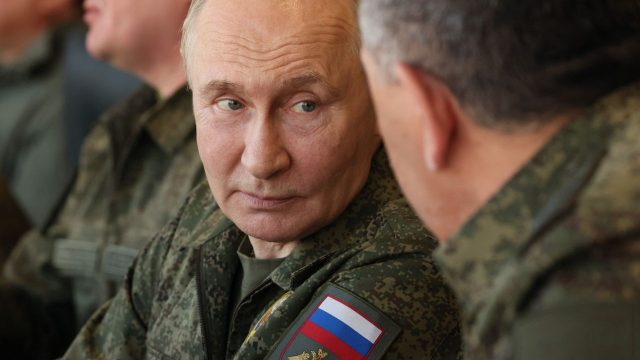
Days after Polish and Nato forces scrambled to shoot down Russian drones that had flown into Poland’s airspace, Russian troops gathered in neighbouring Belarus for largescale war games; Indian and Iranian troops also participated. The Zapad 2025 exercises included a simulated nuclear strike. Although they were billed as defensive, analysts said they were designed to intimidate Europe.
In total, 19 drones crossed into Poland last Wednesday. Moscow’s allies claimed that they had strayed there accidentally, but days later, another Russian drone violated Romanian airspace. Warsaw said the incursion was a test of Nato’s defensive capabilities, and invoked Article 4, which brings a threat to the attention of its council. Nato then launched an operation to bolster its eastern flank. Donald Trump said he would impose tougher sanctions on Russia – but only if all Nato members stop buying Russian oil and gas and slap heavy tariffs on China.
‘Chinks in the alliance’s armour’
The sheer scale of the incursion into Poland makes it clear that this was a “calculated escalation” by Vladimir Putin”, said The Daily Telegraph. Emboldened by Trump’s indulgence, he wanted to see if Nato had the resolve to respond. Poland has painful recent experience of invasion and occupation, said The Independent. So its PM Donald Tusk’s warning that the prospect of conflict in Europe is “closer than at any time since the Second World War”, has to be taken seriously: this was the first time in Nato’s history that its member states have had to directly attack Russian forces, albeit unmanned ones.
Fortunately, for all Trump’s vacillations, Nato was still strong enough to answer the call. Yet there are “chinks in the alliance’s armour”, said The Times. Two of its members, Hungary and Slovakia, are “virtual allies of Russia”. And the leader of the US, its most powerful member, treats the Ukraine War as a “business opportunity”. Trump is making European nations buy US weapons to give to Kyiv; now he’s trying to stop them buying Russian gas, to boost sales of US liquefied natural gas.
Warning shots
Ever since Russian tanks rolled into Ukraine, Western strategists have been asking who the Kremlin would target next, said Mark Almond in the Daily Mail. The consensus was that “small, militarily weak nations on Russia’s border”, such as Latvia or Estonia, would be the target. Yet instead, Putin picked Poland, a country which spends nearly 5% of its GDP on defence – the highest share of any Nato member – and has the third-largest standing army in the alliance, after the US and Turkey.
Does this suggest we are “teetering on the edge of World War Three”? These warning shorts certainly expose our weaknesses, said Edward Lucas in The Times. “The US insists (rightly) that Europe must take the lead in standing up to Russia.” But without it, there is nothing like a unified European alliance. Political stances vary wildly, while even supportive nations, such as France, Spain and Belgium, flinch at the risk and the cost.
Trump’s ‘latest wheeze’
Europe’s Nato powers have more than enough air power to keep the Russians out, said Hamish de Bretton-Gordon in The Daily Telegraph. But they should go further, by establishing a no-fly zone in western Ukraine. This would save thousands of lives; and as a display of power, it could be the “catalyst to get Putin around the negotiating table”.
Nonsense, said Jennifer Kavanagh on UnHerd. Ukraine – in dire straits militarily – has an interest in exaggerating the Russian threat to Europe, to scare the continent into giving more aid. Instead of responding in a bellicose fashion, and risking a wider war, Western leaders should tamp down their rhetoric and “double down on diplomacy”.
Unfortunately, any diplomatic efforts are liable to be scuppered by Trump, said Jason Corcoran in The Moscow Times. His “latest wheeze” – promising to ramp up sanctions on Russia if Nato imposes tariffs of 50% to 100% on Chinese imports – is a “cynical stalling tactic”. He knows that this would be economic suicide for Europe. He is letting Moscow “off the hook, granting Putin much-needed breathing room as the war rages on”.
India’s participation in the Zapad war games, led by the highly respected Kumaon Regiment, has “raised eyebrows” amid signs that the US may be losing a “key ally” in Asia, says Lorraine Mallinder on Al Jazeera. But despite recent tensions over US tariffs, Trump confirmed last week that India and the US were continuing negotiations. Denmark announced on Wednesday that it would buy long-range precision missiles and drones, for the first time, to combat the threat from Russia. “Russia is testing us,” said Danish PM Mette Frederiksen.
Incursion into Poland and Zapad 2025 exercises seen as a test for Europe






